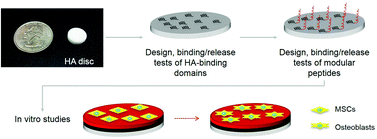Stable biofunctionalization of hydroxyapatite (HA) surfaces by HA-binding/osteogenic modular peptides for inducing osteogenic differentiation of mesenchymal stem cells†
Abstract
Hydroxyapatite (HA), the principal component of bone mineral, shows osteoconductive properties when employed for coating metal implants as well as scaffold materials in synthetic bone grafts. With the goal of providing this material with osteoinductive capabilities to promote faster bone regeneration, we show an easy approach to functionalize HA implant surfaces and enrich them with osteoinductive properties by the use of HA-binding modular peptides. The modular peptides are designed as a combination of two domains, an HA-binding peptide motif and an osteogenic peptide motif derived from the osteogenic growth peptide (OGP) or bone morphometric protein 7 (BMP-7). To identify the best HA-binding peptide, several nature-inspired peptides derived from natural bone extracellular matrix proteins (bone sialoprotein, osteonectin, osteocalcin, and salivarin statherin) were compared for HA-binding activity, revealing concentration-dependent and incubation-time-dependent behaviours. We discovered that a Poly-E heptamer (E7) is the best HA-binding peptide, and thus combined it with a second osteogenic peptidic domain to create an osteoinductive modular peptide. After binding/release characterization, we found that the addition of the second osteogenic peptide domain did not change the binding profile of the modular peptides and caused only a slight change in their release kinetics. Mesenchymal stem cells (MSCs) were cultured on the HA substrates functionalized with modular peptides, and cell adhesion, proliferation, and differentiation in a basal medium (i.e., without any osteogenic supplements) were investigated. Gene expression data clearly showed that MSCs were committed to differentiate into osteoblasts in the presence of the modular peptides. HA discs functionalized with the E7 BMP-7 modular peptide showed the best capability in inducing the osteogenic differentiation of MSCs among all modular peptides studied. The modular peptides can easily be used to functionalize the HA implants through its constituent HA-binding motif, leaving the osteogenic peptide motif protruding from the surface for inducing osteogenesis. Our work opens up a new approach to the formulation of new bioactive HA coatings and implants for bone and dental repair.


 Please wait while we load your content...
Please wait while we load your content...